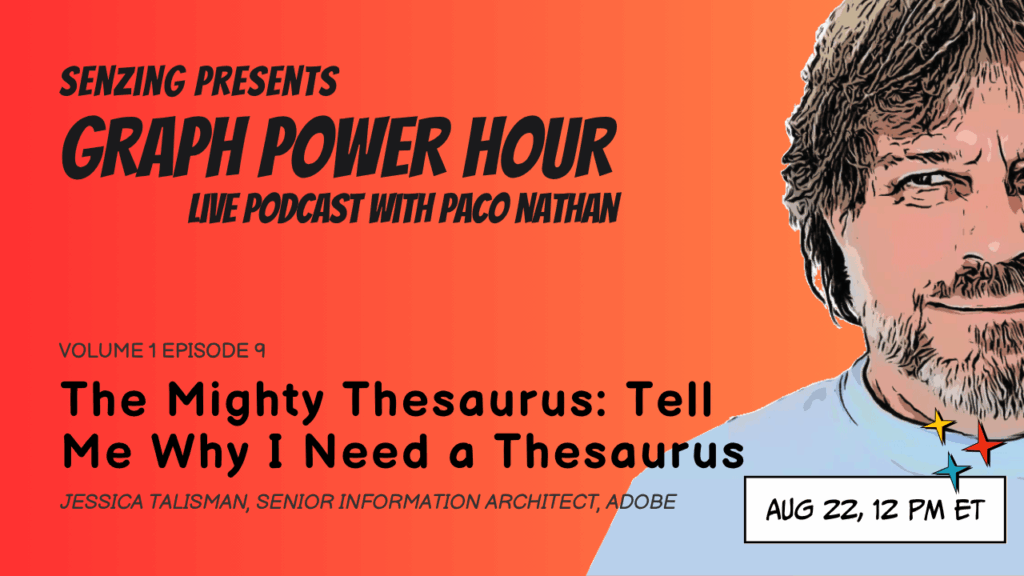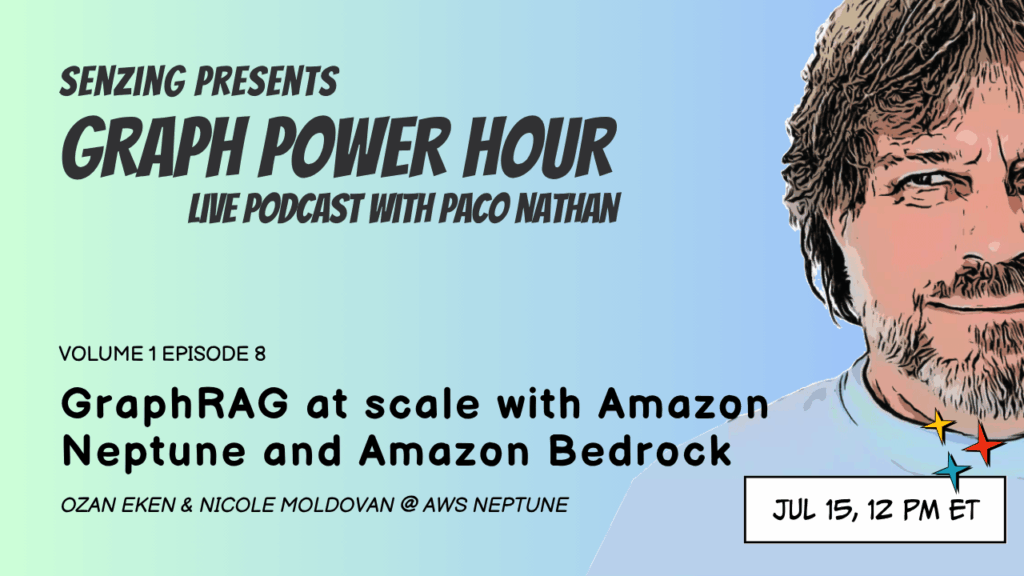Graph Power Hour Ep 3
Uncovering Hidden Patterns:
The Power of Temporal Knowledge Graphs
Webinar Series with Paco Nathan & Featuring Chia Jeng Yang & Tom Smoker from WhyHow.AI
Watch the third podcast of Paco Nathan’s Graph Power Hour. This week’s topic – Uncovering Hidden Patterns: The Power of Temporal Knowledge Graphs.
ABOUT THIS EPISODE
Temporal knowledge graphs are a powerful tool for managing complex, time-dependent data. As organizations grapple with ever-increasing amounts of unstructured information, the ability to track how relationships and patterns evolve over time is a key element to extracting value from data. While graphs have proven valuable for improving context in AI applications, adding the temporal dimension introduces new challenges along with opportunities for deeper insights.
The transition from theory to practice reveals significant complexity. Converting unstructured text into temporal knowledge graphs requires carefully balancing high-level ontology design with practical implementation concerns. Paco’s guests Chia Jeng Yang and Tom Smoker from WhyHow.AI share their experiences working with medical records, congressional hearing transcripts and legal documents – demonstrating how different domains require tailored approaches that impact how text chunking, entity resolution, temporal relationship modeling and more are handled. Throughout the discussion, they highlight open source tools that help developers tackle these challenges, including Knowledge Table for data extraction and Knowledge Graph Studio for graph construction.
Real-world applications demand pragmatic solutions. The speakers emphasize their commitment to open source development, having released key components of their infrastructure under MIT licenses to help enterprises build robust knowledge graph systems. They discuss their hybrid approach to building these systems, combining symbolic and statistical reasoning to meet specific industry needs. This includes developing multi-agent systems where different agents handle specialized tasks like navigating legal clauses, managing definitions and processing footnotes. The discussion emphasizes the importance of maintaining auditability and explainability, particularly in regulated industries such as healthcare, legal and finance.
In this talk, we will explore the use of graphs “from the trenches,” examining real-world challenges encountered when applying them in complex systems. While graphs offer immense theoretical potential, translating that into practical applications often reveals unforeseen difficulties. From handling incomplete, ambiguous, or unresolved data to scaling large, interconnected datasets, the journey is rarely straightforward. We’ll also discuss the challenges of integrating graphs with AI models, where the structured nature of graphs can clash with the messiness of real-world information. These practical insights will highlight the gap between the idealized use of graphs and the realities faced in the field.
Key Topics:
- Temporal knowledge graph fundamentals and architectures
- Practical implementation challenges in regulated industries
- Semi-structured data handling across different verticals
- Multi-agent systems for complex document processing
- Open-source tools for graph construction and maintenance
Key Takeaways:
- Start with basic graph structures that solve immediate business needs. Attempting to model everything at once often leads to overly complex, impractical implementations
- When handling temporal data, use discrete time points and versioning rather than trying to model continuous time – this makes the system more maintainable and queryable.
- Different industries require tailored approaches – for example, legal documents need recursive parsing for cross-references, while medical records benefit from standardized ontologies.
- Breaking down complex document processing using multiple specialized agents improves both accuracy and auditability.
- Leveraging open source tools for data extraction and graph construction allows teams to focus on their unique domain challenges rather than building infrastructure from scratch.
Resources Mentioned in this Episode:
- Knowledge Table Code Repository
- Knowledge Graph Studio Code Repository
- Synthea™ Synthetic Patient Generator
- FHIR Patient Ontology (JSON Schema)
Case studies:
We’d love to see you at our next event! Keep an eye out for our upcoming webinars by subscribing to our mailing list and following Senzing on LinkedIn.
Related Videos
Paco Nathan
Principal DevRel Engineer
Paco Nathan leads DevRel for the Entity Resolved Knowledge Graph practice area at Senzing and is a computer scientist with +40 years of tech industry experience and core expertise in data science, natural language, graph technologies, and cloud computing. He’s the author of numerous books, videos, and tutorials about these topics.




